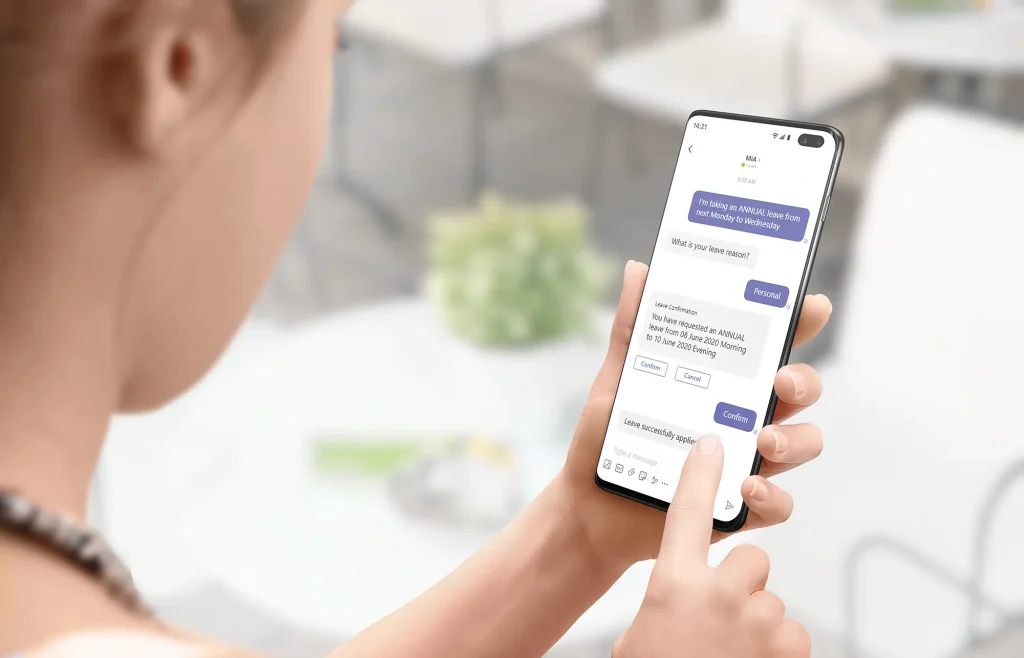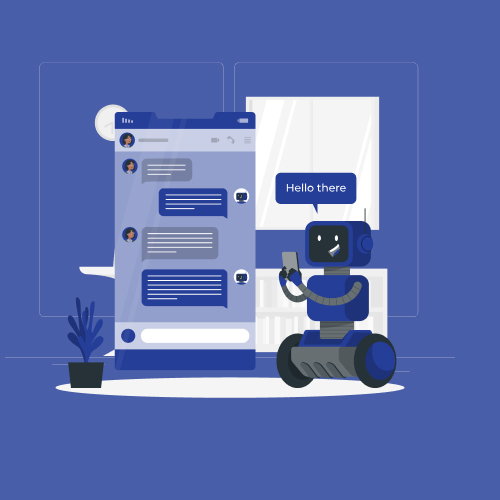In the evolving landscape of Human Resources, HR chatbots have emerged as a transformative tool for streamlining administrative processes and enhancing employee interaction.
These AI-powered virtual assistants are specifically designed to handle HR-related queries and tasks, providing instantaneous support without the need for human intervention.
What is an HR chatbot?

An HR chatbot is an intelligent system integrated within HR platforms to automate and manage routine activities like answering employee queries, assisting in onboarding processes, scheduling interviews, and conducting feedback surveys.
These chatbots leverage Natural Language Processing (NLP) to understand and respond to user inquiries naturally and effectively. With the capacity to operate 24/7, they are essential for ensuring efficiency and accessibility in HR departments.
The growing role of chatbots in HR
The significance of HR chatbots in modern workplaces is escalating due to their ability to offload repetitive tasks from HR personnel, allowing them to focus on strategic roles.
This shift not only fosters enhanced operational productivity but also augments workforce engagement by providing timely support and accurate information.
As businesses aim to optimise their HR functions, implementing HR chatbots becomes imperative. It allows organisations to easily integrate AI capabilities into their HR practices, paving the way for smarter decision-making and resource management.
With the growing necessity for agility and adaptability, this technology is not just a trend but a critical component for a forward-thinking HR strategy.
When implementing HR chatbots in your department, a well-structured strategy is crucial. Establishing an effective HR chatbot strategy involves several critical steps and considerations that can ensure a successful integration into your HR processes.
Critical steps for developing a chatbot strategy
Before deploying AI chatbots in HR, you must define clear objectives.
Consider what you aim to achieve, such as enhancing employee engagement or optimising routine HR tasks like leave requests and onboarding.
Develop a roadmap that aligns with these objectives, involving key stakeholders across departments to foster collaboration and buy-in.
Establish a comprehensive strategy that includes goals, scope, timeline, and metrics to measure success.
HR processes for chatbot automation
Identifying HR processes that can be automated is essential to maximise the benefits of HR chatbot integration. Common processes include:
- Recruitment: Automate screening, scheduling interviews, and providing updates to candidates.
- Onboarding: Use chatbots to guide new hires through procedures and introduce them to company policies.
- Performance management: Track progress, gather feedback, and assist in setting goals through automated systems.
- Employee wellness: Chatbots can monitor employee wellbeing by collecting feedback and scheduling wellness activities.
Importance of cross-departmental collaboration
Success in deploying AI chatbots in HR often hinges on effective cross-departmental collaboration.
Involving IT, HR, and Compliance teams ensures that the chatbot will integrate seamlessly with existing systems and adhere to data privacy regulations. By working together, these teams can also identify potential technical hurdles early, preventing costly delays and ensuring a smooth rollout.
The planning phase is fundamental to the success of your HR chatbot initiative. By carefully crafting a strategy, identifying suitable HR processes, and fostering cross-departmental collaboration, you can optimise employee interactions and elevate your HR department’s functionality.
Technical requirements for deploying HR chatbots
The foundation of a successful chatbot implementation lies in its technical architecture.
Begin by assessing the current IT infrastructure to accommodate the chatbot’s functionalities. Ensure that your systems can handle the volume of inquiries, require minimal maintenance, and facilitate quick updates.
Employing a scalable cloud-based solution can be advantageous, providing flexibility and growth capacity.
Additionally, it’s crucial to integrate robust data protection measures to safeguard employee data, adhering to local technology and privacy guidelines.
Integration challenges
While implementing HR chatbots may seem straightforward, several integration challenges can arise.
One of the most pressing is ensuring compatibility with existing HR management systems. Unearth potential issues tied to legacy systems that might not support advanced integrations.
By leveraging modern, API-driven platforms, you can bridge existing HR tools with new chatbot technology effectively.
Collaboration with IT and tech partners will be pivotal to address any unforeseen complications during the transition.
Ensuring compatibility with existing systems
For optimal chatbot performance, ensure that your chatbot aligns seamlessly with your existing HR technology stack.
Compatibility goes beyond technical feasibility; it encompasses aligning the chatbot’s capabilities with your HR team’s workflow.
Implementing features like Efficient HR Requests and Approvals can lead to significantly reduced processing times and increased workflow efficiency.
The chatbot should integrate smoothly with Human Capital Management (HCM) systems to manage tasks such as employee onboarding, attendance tracking, and payroll automation without hiccups.
Ultimately, while implementing HR chatbots, a seamless user experience is paramount. Beyond technical prowess, think about end-user convenience; interface design, navigation simplicity, and accessibility should be top priorities. Timely testing and receiving feedback from a pilot run will pave the way for refining user experience and boosting employee acceptance.
As you embark on the journey of implementing HR chatbots, it is crucial to monitor their performance and measure the Return on Investment (ROI). Tracking these metrics not only validates the effectiveness of your chatbot strategy but also uncovers areas of improvement for achieving strategic HR goals.
Key metrics for evaluating chatbot performance

Successful HR chatbot integration involves tracking specific metrics to evaluate performance. Some of the critical KPIs include:
- User engagement: Monitor how often employees interact with the chatbot and the average session duration.
- Query resolution rate: Measure the rate at which employee queries are resolved without human intervention.
- Response time: Evaluate the average time taken by the chatbot to respond to queries, ensuring timely support.
- User feedback: Collect feedback from employees to gauge satisfaction and areas needing improvement.
Tracking ROI from chatbot implementation
Understanding the financial impact of deploying AI chatbots in HR is imperative.
ROI assessment primarily revolves around cost reduction in administrative tasks and productivity gains. Here are some ways to track ROI:
- Cost savings: Calculate savings from reduced need for manual processing in tasks like onboarding and recruitment.
- Productivity metrics: Use metrics such as time saved in handling routine queries to assess productivity improvements.
- Compliance: Measure improvements in compliance through consistent handling of policy-related queries.
Establishing feedback mechanisms for continuous improvement
Implementing a robust feedback mechanism is central to optimising HR chatbot solutions.
Encourage employees to provide feedback through surveys, which can be automated via the chatbot itself. Regular reviews of this feedback ensure that the chatbot evolves to meet employee needs, thereby enhancing overall efficiency and satisfaction.
Utilise data-driven insights from this feedback to make continuous updates and segment analysis for targeted improvements.
Best practices for scaling
Implementing HR chatbots is only the beginning. Optimisation and scaling are crucial to ensure that these tools continually provide value to your HR operations.
This section will focus on strategies to enhance chatbot performance and methods to expand their capabilities within your HR department.
For successful scalability, businesses should:
- Start small: Begin with a pilot phase to test effectiveness on a smaller scale, then expand gradually based on insights gathered.
- Utilise cloud solutions: Employ cloud-based infrastructures for flexibility and scalability to accommodate increasing data volume and user traffic.
- Leverage real-time data: Use real-time analytics to adjust strategies and operations swiftly, ensuring that the chatbot evolves with your company’s needs.
Optimisation techniques for improving chatbot performance
Optimisation isn’t a one-time thing; it’s a continuous process. Consider the following techniques:
- Regular updates and maintenance: Regularly update the chatbot’s software to refine its capabilities and fix bugs that could hinder its performance.
- Feedback loop: Establish a consistent feedback loop with employees to identify and address areas where the chatbot can improve.
- Machine learning integration: Implement machine learning models to make the chatbot more responsive and intuitive, leading to more personalised employee interactions.
- Software integration: Continuously integrate the chatbot with the latest HRIS systems for enhanced compatibility and functionality.
By focusing on scalability and consistent optimisation, HR departments can ensure that their chatbot solutions are both robust and efficient. Together, these strategies can transform HR functions, leading to smarter spending decisions and enhanced employee engagement.
Avoiding common pitfalls
Embarking on the journey of implementing AI-powered HR chatbots can be transformative, yet it comes with its set of challenges. Avoiding common pitfalls during this deployment phase is essential to ensure success and maximise benefits.
- Overlooking employee training: Ensure comprehensive training is provided to employees. Familiarity with the chatbot will boost engagement levels and lead to higher adoption rates.
- Ignoring feedback: Establish a feedback loop where employees can share their experiences and suggestions for improvement. An open channel for such communication is crucial for continuous refinement of the chatbot’s functionality.
- Neglecting integration: Missteps in integration can severely impede chatbot efficiency. Collaborate with IT to ensure seamless compatibility with existing HR systems and updated API protocols.
- Undervaluing data privacy: Protecting employee data should always be a priority. Implement robust privacy measures consistent with local labour laws to maintain trust and compliance.
Through keen attention to these areas, organisations can leverage solutions like MiHCM’s suite to not just deploy but optimise HR chatbot functionalities effectively. The results include enhanced employee experiences, streamlined HR processes, and informed decision-making via data-driven insights.



